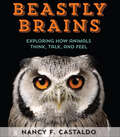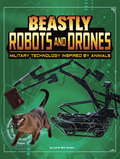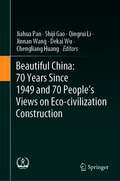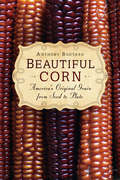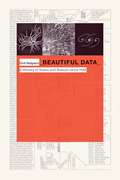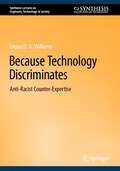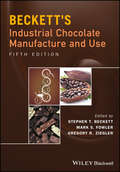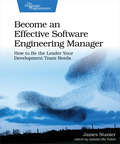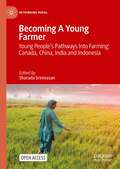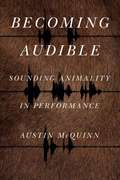- Table View
- List View
Beastly Brains: Exploring How Animals Think, Talk, and Feel
by Nancy F. Castaldo* "This eye-opening, cogent, and well-structured volume will enlighten students to both the richness of the animal kingdom and the nature of intelligence itself." — Booklist, STARRED review "Castaldo (The Story of Seeds) presents a thought-provoking look at the minds and perceptions of animals, as well as the way human understanding of the subject has evolved..." —Publishers Weekly "The information is conveyed in an enticing way that is sure to spark the interest of aspiring naturalists and researchers... A fascinating take on animal science for tween and teen zoologists." — School Library Journal —
Beastly Firepower: Military Weapons and Tactics Inspired by Animals (Beasts and the Battlefield)
by Lisa M. SimonsIn the wild, animals use teeth, claws, and other natural weapons to attack their prey. On the battlefield, soldiers need weapons to fight the enemy. Military forces have often looked to nature for inspiration to develop effective weapons and combat tactics. From the first feathered arrows to tomorrow's high-tech weaponry, take a look at how military technology often imitates the natural weapons of animals to help soldiers succeed in combat. Then be sure to catch the other amazing titles in the Beasts and the Battlefield series.
Beastly Robots and Drones: Military Technology Inspired by Animals (Beasts and the Battlefield)
by Lisa M. SimonsAnimals have many traits that help them survive in the wild. Inspired by animals' incredible abilities, military forces have created many machines over the years to achieve success on the battlefield. From the first remote-controlled vehicles to the advanced machines of tomorrow, take a look at how military robots and drones often imitate the abilities of animals throughout nature. Then be sure to catch the other amazing titles in the Beasts and the Battlefield series.
Beasts on the Battlefield: Animals in Combat (Beasts and the Battlefield)
by Charles C. HoferAnimals have played an important role in warfare throughout history. Military forces have long relied on animals' natural abilities to achieve their missions. From medieval warriors charging into combat on horseback to dolphins locating explosive mines at sea, take a look at the many ways animals have helped armies find success on the battlefield. Then be sure to catch the other amazing titles in the Beasts and the Battlefield series.
Beat Sugar Addiction Now! The Cutting-Edge Program That Cures Your Type of Sugar Addiction and Puts You on the Road to Feeling Great and Losing Weight!
by Jacob Teitelbaum Chrystle FiedlerSugar sensitivity is as powerful an addiction as tobacco or alcohol--and one of the most difficult to break die to sugar's prevalence in the modern diet. With one-third of our calories coming from sugar, white flour, and processed foods sugar addiction is a rapidly growing epidemic. However, unlike other addictions going "cold turkey" won't fix it nor will a "one size fits all" approach. In this groundbreaking book, nationally recognized physician Dr. Jacob Teitelbaum uncovers four distinct sugar addiction types and gives a step-by-step plan for resolving their underlying causes and breaking sugar cravings forever.
Beating Your Competition Through Quality
by D. B. OwenThis book describes how superior quality is attained and gives some of the basic techniques involved. It gives clear insight into the impact of variation on the future of the World and addresses the statistical problems.
Beatlemania: Technology, Business, and Teen Culture in Cold War America (Johns Hopkins Introductory Studies In The History Of Science)
by André MillardThis look at how changes in the music industry made the Fab Four phenomenon possible “presents a different interpretation of a much-studied topic” (Essays in Economic and Business History).In this unique study, André Millard argues that, despite the Beatles’ indisputable skill, they would not have attained the same global recognition or been as influential without the convergence of significant developments in the way music was produced, recorded, sold, and consumed. As the Second Industrial Revolution hit full swing and baby boomers came of age, the reel-to-reel recorder and other technological advances sped the evolution of the music business. Musicians, recording studios and record labels, and music fans used and interacted with music-making and -playing technology in new ways. Higher quality machines made listening to records and the radio an experience that one could easily share with others, even if they weren’t in the same physical space. At the same time, an increase in cross-Atlantic commerce—especially of entertainment products—led to a freer exchange of ideas and styles of expression, notably among the middle and lower classes in the U.S. and the UK. At that point, Millard argues, the Beatles rode their remarkable musicianship and cultural savvy to an unprecedented bond with their fans—and spawned Beatlemania.Lively and insightful, Beatlemania offers a deeper understanding the days of the Fab Four and the band’s long-term effects on the business and culture of pop music.
Beatlemania: Technology, Business, and Teen Culture in Cold War America (Johns Hopkins Introductory Studies in the History of Technology)
by André MillardThe fame, talent, and success of the Beatles need no introduction. Nor does the world need another book exploring the band's skill and its influence on music and society in the United States, Britain, and the rest of the world. André Millard instead studies the Beatlemania phenomenon from an original perspective—the relationship among the music business, recording technologies, and teens and young adult culture of the era. Millard argues that, despite the Beatles’ indisputable skill, they would not have attained the global recognition and been as influential without the convergence of significant developments in the way music was produced, recorded, sold, and consumed. As the Second Industrial Revolution hit full swing and baby boomers came of age, the reel-to-reel recorder and other technological advances sped the evolution of the music business. Musicians, recording studios and record labels, and music fans used and interacted with music-making and -playing technology in new ways. Higher quality machines made listening to records and the radio an experience that one could easily share with others, even if they weren’t in the same physical space. At the same time, an increase in cross-Atlantic commerce—especially of entertainment products—led to a freer exchange of ideas and styles of expression, notably among the middle and lower classes in the U.S. and the UK. At that point, Millard argues, the Beatles rode their remarkable musicianship and cultural savvy to an unprecedented bond with their fans—and spawned Beatlemania. Refreshing and insightful, Beatlemania offers a deeper understanding the days of the Fab Four and the band’s long-term effects on the business and culture of pop music.
Beautiful Blue World
by Suzanne LafleurBeautiful Blue World is a thrilling and moving story of children who become the key to winning a war. Sofarende is at war. For twelve-year-old Mathilde, it means food shortages, feuding neighbors, and bombings. Even so, as long as she and her best friend, Megs, are together, they’ll be all right. But the army is recruiting children, and paying families well for their service. If Megs takes the test, Mathilde knows she will pass. Megs hopes the army is the way to save her family. Mathilde fears it might separate them forever. This touching and suspenseful novel is a brilliant reimagining of war, where even kindness can be a weapon, and children have the power to see what adults cannot.From the Hardcover edition.
Beautiful Blue World
by Suzanne LafleurBeautiful Blue World is a thrilling and moving story of children who become the key to winning a war. Sofarende is at war. For twelve-year-old Mathilde, it means food shortages, feuding neighbors, and bombings. Even so, as long as she and her best friend, Megs, are together, they'll be all right. But the army is recruiting children, and paying families well for their service. If Megs takes the test, Mathilde knows she will pass. Megs hopes the army is the way to save her family. Mathilde fears it might separate them forever. This touching and suspenseful novel is a brilliant reimagining of war, where even kindness can be a weapon, and children have the power to see what adults cannot.From the Hardcover edition.
Beautiful China: 70 Years Since 1949 and 70 People’s Views on Eco-civilization Construction
by Jiahua Pan Shiji Gao Qingrui Li Jinnan Wang Dekai Wu Chengliang HuangThis book discusses and studies the basic course of ecological civilization construction in the 70 years since the founding of the People’s Republic of China and summarizes the experience and lessons. It contains 75 articles from 75 top experts and government officials in the field of ecological civilization policy-making and basic theory research in China, including Xi Jinping Thought on Ecological Civilization, ecological culture, green industry economy, environmental quality, legal system, ecological security and so on, so as to provide reference for understanding and studying the progress of ecological environment protection since the founding of China.
Beautiful Corn: America's Original Grain from Seed to Plate
by Anthony BoutardCultivated from sea level to mountaintop, from parched deserts to sodden rain forests, from the rocky Gaspé Peninsula to the plains of Argentina, corn is the grain of the Americas. In terms of culinary uses, it is amazingly diverse, reflecting the breathtaking variety of the continents and environments from which it evolved. The consummate immigrant, corn is grown extensively on every continent except Antarctica. Market farmer and naturalist Anthony Boutard weaves together this unique plant's contribution to our culture, its distinctive biology, and the practical information needed to grow and enjoy it at home. Beautiful Corn advocates a return to the nourishing whole grain that built America, in place of today's genetically modified crops processed by industrial agriculture into synthetic sweeteners and cheap meat. Come along on this lyrical and inspiring journey through the seasons, learning about growing and using corn in the traditional way. Gardeners and market farmers can lead the way to a healthier country by restoring heritage corn varieties to our tables. An unabashed celebration of a much-maligned culinary treasure, Beautiful Corn will forever change the way you view this remarkable plant. Anthony Boutard is a widely recognized advocate in the local food movement, well-known for his efforts in reviving long-lost crops and bringing little-known varieties to market. He and his wife Carol own Ayers Creek Farm, a 144-acre organic market farm in Gaston, Oregon, specializing in berries, beans, grains, and greens for sale to local restaurants and markets.
Beautiful Data: A History of Vision and Reason since 1945
by Orit HalpernBeautiful Data is both a history of big data and interactivity, and a sophisticated meditation on ideas about vision and cognition in the second half of the twentieth century. Contending that our forms of attention, observation, and truth are contingent and contested, Orit Halpern historicizes the ways that we are trained, and train ourselves, to observe and analyze the world. Tracing the postwar impact of cybernetics and the communication sciences on the social and human sciences, design, arts, and urban planning, she finds a radical shift in attitudes toward recording and displaying information. These changed attitudes produced what she calls communicative objectivity: new forms of observation, rationality, and economy based on the management and analysis of data. Halpern complicates assumptions about the value of data and visualization, arguing that changes in how we manage and train perception, and define reason and intelligence, are also transformations in governmentality. She also challenges the paradoxical belief that we are experiencing a crisis of attention caused by digital media, a crisis that can be resolved only through intensified media consumption.
Beautiful You
by Chuck Palahniuk"A billion husbands are about to be replaced." From the author of Fight Club, the classic portrait of the damaged contemporary male psyche, now comes a novel about the apocalyptic marketing possibilities of female pleasure. Sisters will be doing it for themselves. And doing it. And doing it. And doing it some more. . . Penny Harrigan is a low level associate in a big Manhattan law firm with an apartment in Queens and no love life at all. So it comes as a great shock when she finds herself invited to dinner by one C. Linus Maxwell, aka "Climax-Well," a software mega-billionaire and lover of the most gorgeous and accomplished women on earth. After dining at Manhattan's most exclusive restaurant, he whisks Penny of to a hotel suite in Paris, where he proceeds, notebook in hand, to bring her to previously undreamed-of heights of orgasmic pleasure for days on end. What's not to like? This: Penny discovers that she is a test subject for the final development of a line of sex toys to be marketed in a nationwide chain of boutiques called "Beautiful You." So potent and effective are these devices that women by the millions line up outside the stores on opening day and then lock themselves in their room with them and stop coming out. Except to buy batteries. Maxwell's plan for erotically enabled world domination must be stopped. But how?
Beautiful You
by Chuck Palahniuk"A billion husbands are about to be replaced."From the author of Fight Club, the classic portrait of the damaged contemporary male psyche, now comes this novel about the apocalyptic marketing possibilities of a new product that gives new meaning to the term "self-help." Penny Harrigan is a low-level associate in a big Manhattan law firm with an apartment in Queens and no love life at all. So it comes as a great shock when she finds herself invited to dinner by one C. Linus Maxwell, a software mega-billionaire and lover of the most gorgeous and accomplished women on earth. After dining at Manhattan's most exclusive restaurant, he whisks Penny off to a hotel suite in Paris, where he proceeds, notebook in hand, to bring her to previously undreamed-of heights of gratification for days on end. What's not to like? This: Penny discovers that she is a test subject for the final development of a line of feminine products to be marketed in a nationwide chain of boutiques called Beautiful You. So potent and effective are these devices that women by the millions line up outside the stores on opening day and then lock themselves in their room with them and stop coming out. Except for batteries. Maxwell's plan for battery-powered world domination must be stopped. But how? From the Hardcover edition.
Beautiful: The Life of Hedy Lamarr
by Stephen Michael Shearer“A fascinating biography that re-creates Hollywood’s Golden Age of Glamour” as it recounts the life of the star and inventor (Publishers Weekly).Hedy Lamarr’s exotic beauty was heralded across Europe in the early 1930s. Yet she became infamous for her nude scenes in the scandalous movie Ecstasy. Trapped in a marriage to one of Austria’s munitions barons, a friend of Mussolini’s who hid his Jewish heritage to become an “honorary Aryan” at the onset of World War II, Lamarr fled Europe for Hollywood, where she was transformed into one of cinema’s most glamorous stars, appearing opposite such actors as Clark Gable, Spencer Tracy, and James Stewart. As her career faded, she went from one husband to the next, her personal troubles and legal woes casting a shadow over her phenomenal intelligence and former image.Stephen Michael Shearer separates the truth from the rumors regarding the life of Hedy Lamarr, and highlights her astonishing role as inventor of a technology that has become an essential part of everything from military weaponry to today’s cell phones.Praise for Beautiful“In Beautiful, Mr. Shearer writes with humor and has fun with some of the glorious nonsense of Lamarr’s movies.” —Jeanine Basinger, The Wall Street Journal“Much more than a standard Hollywood biography.” —Edge Magazine
Beauty in Chemistry: Artistry in the Creation of New Molecules (Topics in Current Chemistry #323)
by Luigi FabbrizziThe Beauty of Chemistry in the Words of Writers and in the Hands of Scientists, by Margherita Venturi, Enrico Marchi und Vincenzo Balzani Living in a Cage Is a Restricted Privilege, by Luigi Fabbrizzi Inner and Outer Beauty, by Kenneth N. Raymond und Casey J. Brown The Mechanical Bond: A Work of Art, by Carson J. Bruns und J. Fraser Stoddart The Beauty of Knots at the Molecular Level, by Jean-Pierre Sauvage und David B. Amabilino
Beazley's Design and Detail of the Space between Buildings
by A. PinderA new edition of a book widely regarded as a classic of landscape architecture, it deals with the 'bits' that go in between the different parts of the urban landscape. A completely updated text makes it suitable for both the professional and student.
Because Technology Discriminates: Anti-Racist Counter-Expertise (Synthesis Lectures on Engineers, Technology, & Society #27)
by Logan D. WilliamsEngineers designing technologies and systems produce problems when they do not account for existing biases in society. Designers have a mandate to make technologies efficiently, economically, and ethically. This textbook is written for both students and practicing designers, engineers, researchers, or artists who want to create more ethical designs; it aims to help readers understand how race is implicated in technology design. Learning from historical and contemporary case studies of engineering and architecture projects will help readers see clearly the power of design decisions to either perpetuate or contest racism. Chapter exercises will change engineers’ mental models to see the bias inherent to existing technological design. By incorporating the knowledge and insights of community-based experts into design projects, readers will begin to practice anti-racist leadership and counter-expertise.
Beckett's Industrial Chocolate Manufacture and Use
by Steve T. Beckett Gregory R. Ziegler Mark S. FowlerSince the publication of the first edition of Industrial Chocolate Manufacture and Use in 1988, it has become the leading technical book for the industry. From the beginning it was recognised that the complexity of the chocolate industry means that no single person can be an expert in every aspect of it. For example, the academic view of a process such as crystallisation can be very different from that of a tempering machine operator, so some topics have more than one chapter to take this into account. It is also known that the biggest selling chocolate, in say the USA, tastes very different from that in the UK, so the authors in the book were chosen from a wide variety of countries making the book truly international. Each new edition is a mixture of updates, rewrites and new topics. In this book the new subjects include artisan or craft scale production, compound chocolates and sensory.This book is an essential purchase for all those involved in the manufacture, use and sale of chocolate containing products, especially for confectionery and chocolate scientists, engineers and technologists working both in industry and academia.The new edition also boasts two new co-editors, Mark Fowler and Greg Ziegler, both of whom have contributed chapters to previous editions of the book. Mark Fowler has had a long career at Nestle UK, working in Cocoa and Chocolate research and development – he is retiring in 2013. Greg Ziegler is a professor in the food science department at Penn State University in the USA.
Become a Competent Music Producer in 365 Days
by Sam GeorgeBecome a Competent Music Producer in 365 Days is a comprehensive, step-by-step guide to the fundamentals of music-production. Over the course of a year, this book takes the reader through ten chapters covering mixing, equalization, compression, reverb, delay and modulation, automation, vocals, synthesis, and mastering. To combat the patchy nature of ‘fast’ online content, this book provides an accessible and easily digestible course. Each chapter is broken down into daily readings and tasks, so that each topic can be fully explored, understood, and implemented before moving onto the next, with a range of online video tutorials that offer useful companion material to the book. Become a Competent Music Producer in 365 Days is an ideal introduction for beginners of all backgrounds, and students in further and higher education music-production classes, as well as aspiring professionals, hobbyists, and self-taught producers, who wish to have a thorough grasp on all the fundamental topics that any experienced music producer should know.
Become an Effective Software Engineering Manager: How To Be The Leader Your Development Team Needs
by Dr James StanierSoftware startups make global headlines every day. As technology companies succeed and grow, so do their engineering departments. In your career, you'll may suddenly get the opportunity to lead teams: to become a manager. But this is often uncharted territory. How can you decide whether this career move is right for you? And if you do, what do you need to learn to succeed? Where do you start? How do you know that you're doing it right? What does "it" even mean? And isn't management a dirty word? This book will share the secrets you need to know to manage engineers successfully. Going from engineer to manager doesn't have to be intimidating. Engineers can be managers, and fantastic ones at that. Cast aside the rhetoric and focus on practical, hands-on techniques and tools. You'll become an effective and supportive team leader that your staff will look up to. Start with your transition to being a manager and see how that compares to being an engineer. Learn how to better organize information, feel productive, and delegate, but not micromanage. Discover how to manage your own boss, hire and fire, do performance and salary reviews, and build a great team. You'll also learn the psychology: how to ship while keeping staff happy, coach and mentor, deal with deadline pressure, handle sensitive information, and navigate workplace politics. Consider your whole department. How can you work with other teams to ensure best practice? How do you help form guilds and committees and communicate effectively? How can you create career tracks for individual contributors and managers? How can you support flexible and remote working? How can you improve diversity in the industry through your own actions? This book will show you how. Great managers can make the world a better place. Join us.
Becoming A Digital Marketer: Gaining The Hard And Soft Skills For A Tech-Driven Marketing Career
by Gil Gildner Anya GildnerIn the rapidly paced world of marketing, fresh graduates and traditional marketers alike are learning that the industry is blending with technology at a rate never before seen. <p><p> It's no longer enough to just be a traditional marketer: in today's tech-driven industry, you've got to be able to build websites, install analytics, run pay-per-click campaigns, join Twitter chats, understand SEO strategy, and experience the underrated power of email marketing. In Part 1, you'll learn the hard skills crucial to a marketing career, like: search engine optimization (SEO), pay-per-click advertising (PPC), social media marketing, reporting & analytics, web development, and email marketing. <p> In Part 2, you'll read about the soft skills essential to business, likewriting emails, getting your first entry level position, working as a marketing freelancer, starting your marketing agency, and how to work remotely. <p> Also included are in-depth vignettes and interviews with renowned communicators for insightful alternate views on what makes a successful marketer.Authors Gil & Anya Gildner are the cofounders of Discosloth, a search marketing company that has worked with brands like Volvo, MSF, AirTreks, and have been featured in Inc Magazine, the New York Times, Arkansas Business, the Washington Post, and more. They regularly speak at industry conferences and conduct corporate & academic training seminars.
Becoming A Young Farmer: Young People’s Pathways Into Farming: Canada, China, India and Indonesia (Rethinking Rural)
by Sharada SrinivasanThis open access book is based on a multi-country collaborative research project focussing on Canada, China, India, and Indonesia.It responds directly and concretely to concerns about the generational sustainability of smallholder farming worldwide– reflected in the current UN Decade of Family Farming. Drawing on research that asks how (some) young people continue to pursue a (future) livelihood in farming, the book uses the life-course perspective and privileges voices of young farmers to show that movement away from farming such as time spent in education, migration and non-farm work does not exclude eventual farming futures.The book will be of interest to scholars and students of agrarian studies, anthropology, development studies, gender studies, human geography, rural sociology, and youth studies.
Becoming Audible: Sounding Animality in Performance (Animalibus)
by Austin McQuinnBecoming Audible explores the phenomenon of human and animal acoustic entanglements in art and performance practices. Focusing on the work of artists who get into the spaces between species, Austin McQuinn discovers that sounding animality secures a vital connection to the creatural.To frame his analysis, McQuinn employs Gilles Deleuze and Félix Guattari’s concept of becoming-animal, Donna Haraway’s definitions of multispecies becoming-with, and Mladen Dolar’s ideas of voice-as-object. McQuinn considers birdsong in the work of Beatrice Harrison, Olivier Messiaen, Céleste Boursier-Mougenot, Daniela Cattivelli, and Marcus Coates; the voice of the canine as a sacrificial lab animal in the operatic work of Alexander Raskatov; hierarchies of vocalization in human-simian cultural coevolution in theatrical adaptations of Franz Kafka and Eugene O’Neill; and the acoustic exchanges among hybrid human-animal creations in Harrison Birtwistle’s opera The Minotaur. Inspired by the operatic voice and drawing from work in art and performance studies, animal studies, zooarchaeology, social and cultural anthropology, and philosophy, McQuinn demonstrates that sounding animality in performance resonates “through the labyrinths of the cultural and the creatural,” not only across species but also beyond the limits of the human.Timely and provocative, this volume outlines new methods of unsettling human exceptionalism during a period of urgent reevaluation of interspecies relations. Students and scholars of human-animal studies, performance studies, and art historians working at the nexus of human and animal will find McQuinn’s book enlightening and edifying.
